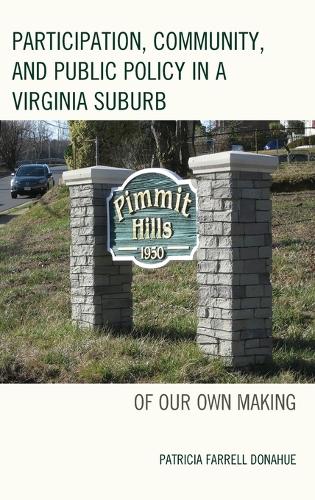
Participation, Community, and Public Policy in a Virginia Suburb: Of Our Own Making
(Hardback)
Publishing Details
Participation, Community, and Public Policy in a Virginia Suburb: Of Our Own Making
By (Author) Patricia Farrell Donahue
Bloomsbury Publishing PLC
Lexington Books
25th September 2017
United States
Classifications
Professional and Scholarly
Non Fiction
History of the Americas
Local history
Political science and theory
Central / national / federal government policies
975.5291
Winner of Ross Netherton Prize for History 2018
Physical Properties
Hardback
294
Width 156mm, Height 239mm, Spine 28mm
617g
Description
Participation, Community, and Public Policy in a Virginia Suburb: Of Our Own Making challenges the conventional wisdom that we can diagnose the vitality of modern American communities using just the few participation trends routinely tracked in social research, such as voting or volunteering. Through the story of Pimmit Hills, Virginia, author Patricia Donahue shows that a community is really the sum of numerous types of participation, and that analyzing a greater variety of activities can help us better understand any community. Pimmit Hills was one of the first federally-financed subdivisions built for World War II veterans, and the residents stories will be familiar to the millions who grew up in middle-class suburbs. At the same time, its proximity to Washington, D.C., gave these residents front-row seats toand sometimes supporting roles inthe launch of national policies that continue to shape America today.
Reviews
Participation, Community, and Public Policy in a Virginia Suburb takes the reader on a captivating journey through more than sixty years of local engagement within a suburban community on the outskirts of Washington, D.C. In deceptively clear and engaging prose, Donahue applies an original, theoretical lens to illuminate the relationship between community participation and policy. Her powerful approach is destined to be taken up by researchers across the globe. -- Rob Stones, Western Sydney University, Australia
Patricia Donahue tells the story of Pimmit Hills, a suburban neighborhood established in 1950 in Fairfax County in Northern Virginia, through the lens of formal, informal, positive, negative, direct, indirect, individual, and group participation, along with nonparticipation, over almost seven decades. She takes the reader by the hand, walks through the neighborhood, looks over neighbors shoulders, thus allowing a close look at this vibrant community. A vital read for urban and suburban community sociologists, historians, and planners. -- Katrin B. Anacker, George Masons Schar School of Policy and Government
Donahue has produced a richly detailed book that depicts the growth of America in microcosm. Her book reflects the development of many American suburbs and the policies that shaped them. It is a wonderful contribution to our understanding of American community development and an essential read for the study of public policy. -- Michael Fauntroy, Howard University
Author Bio
Patricia Farrell Donahue is policy fellow at GMUs Schar School of Policy and Government.
